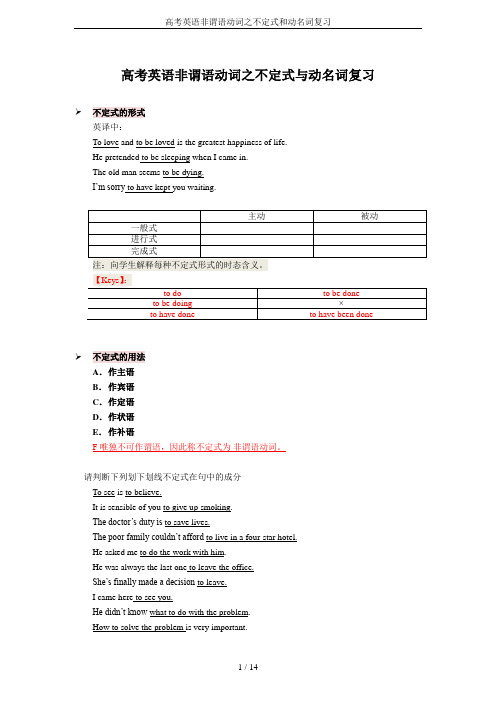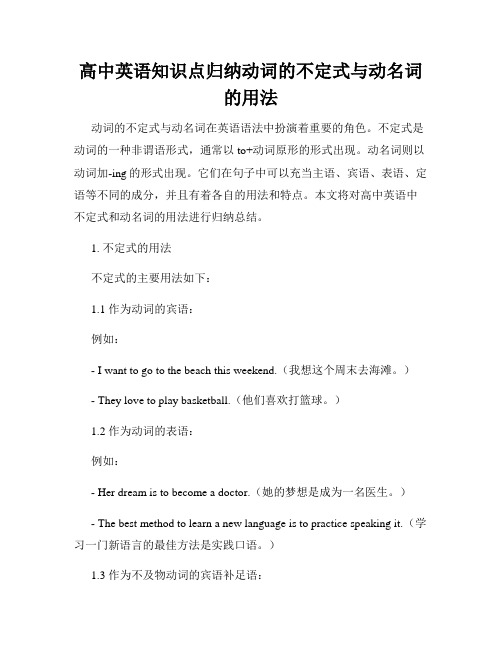不定式和动名词用法复习
- 格式:doc
- 大小:121.54 KB
- 文档页数:21

高考英语非谓语动词之不定式与动名词复习➢不定式的形式英译中:To love and to be loved is the greatest happiness of life.He pretended to be sleeping when I came in.The old man seems to be dying.I’m sorry to have kept you waiting.➢不定式的用法A.作主语B.作宾语C.作定语D.作状语E.作补语F 唯独不可作谓语,因此称不定式为非谓语动词。
请判断下列划下划线不定式在句中的成分To see is to believe.It is sensible of you to give up smoking.The doctor’s duty is to save lives.The poor family couldn’t afford to live in a four-star hotel.He asked me to do the work with him.He was always the last one to leave the office.She’s finally made a decision to leave.I came here to see you.He didn’t know what to do with the problem.How to solve the problem is very important.【Keys】:主语/表语;主语;表语;宾语;宾语补足语;定语;定语;状语;宾语(疑问词+to do);主语❖It 作形式主语,常用结构如下:☞It is + adj. + of/ for sb. + to do sth.☞It is + n. + to do sth. (an honor to make a speak/ a pleasure to see you)☞It takes sb. + 时间段 + to do sth.☞How + adj. + it is + to do sth.! 感叹句How relaxing it is to bathe in the sun on the sands!在沙滩上沐浴阳光多令人放松啊!❖The only, 序数词 the first, the second, 顺序词 the last, the next, 形容词最高级修饰的名词后用不定式作定语。


高中英语知识点归纳动词的不定式与动名词的用法动词的不定式与动名词在英语语法中扮演着重要的角色。
不定式是动词的一种非谓语形式,通常以to+动词原形的形式出现。
动名词则以动词加-ing的形式出现。
它们在句子中可以充当主语、宾语、表语、定语等不同的成分,并且有着各自的用法和特点。
本文将对高中英语中不定式和动名词的用法进行归纳总结。
1. 不定式的用法不定式的主要用法如下:1.1 作为动词的宾语:例如:- I want to go to the beach this weekend.(我想这个周末去海滩。
)- They love to play basketball.(他们喜欢打篮球。
)1.2 作为动词的表语:例如:- Her dream is to become a doctor.(她的梦想是成为一名医生。
)- The best method to learn a new language is to practice speaking it.(学习一门新语言的最佳方法是实践口语。
)1.3 作为不及物动词的宾语补足语:例如:- They made him leave the party.(他们让他离开派对。
)- She saw the cat climb up the tree.(她看到猫爬上树。
)1.4 作为介词的宾语:例如:- He is good at playing the piano.(他擅长弹钢琴。
)- We are interested in learning new things.(我们对学习新事物感兴趣。
)1.5 作为名词的定语:例如:- We need a pen to write the letter.(我们需要一支笔来写信。
)- Is there anything to eat in the fridge?(冰箱里有吃的东西吗?)2. 动名词的用法动名词的主要用法如下:2.1 作为名词的主语:例如:- Swimming is my favorite sport.(游泳是我最喜欢的运动。

不定式和动名词⽤法复习⾮谓语动词讲解---It took me only five minutes to finish the job.(具体)三).不定式和动名词作宾语以及区别(1)不定式做宾语和宾语补⾜语在英语中,介词宾语常⽤动名词,不⽤不定式。
⽽动词宾语,有时⽤动名词,有时⽤不定式,有时⽤动名词和不定式意义变化不⼤,有时意义却相差甚远。
下列动词只能接不定式作(直接)宾语:hope, wish, want, ask, help, refuse, learn, demand, care, choose, arrange, expect, decide, agree, plan, promise, o ffer, manage, pretend, prepare, elect, fail, long, determine,desire等,如:They all agreed to start off early in order to catch the first bus.In spite of the difficulties, we managed to finish the work ahead of time.We expect to be back on Sunday.He chose(decieded) to stay where he was.I'm longing (desiring)to see you.下列动词只能接动名词作(直接)宾语:appreciate, delay, admit, suggest, keep, prevent, miss, risk, escape, imagine, enjoy, consider, avoid, finish, mind, fan cy, practise, advise, pardon, excuse, give up ,keep on, put off, can't help, leave off, feel like, can't stand 等。

初中英语知识点归纳动词的不定式和动名词用法总结动词的不定式和动名词是英语学习中的重要知识点,它们的用法十分多样且常见。
本文将对动词的不定式和动名词的用法进行总结和归纳。
一、动词不定式1. 作主语:例句:To succeed in life is his ultimate goal.成功是他追求的终极目标。
2. 作宾语:a. 接及物动词的宾语:例句:I want to learn English.我想学英语。
b. 接不及物动词的宾语:例句:She decided to go hiking.她决定去徒步旅行。
3. 作表语:例句:Her dream is to become a doctor.她的梦想是成为一名医生。
4. 作补语:a. 表示命令、建议、请求等:例句:She told me to wait for her at the gate.她告诉我在门口等她。
b. 表示目的、目标等:例句:He went to the store to buy some groceries.他去商店买一些杂货。
5. 作定语:例句:We need a person to help us with the project.我们需要一个人来帮助我们完成这个项目。
6. 作状语:a. 表示目的、结果、原因等:例句:He studied hard to pass the exam.他努力学习为了通过考试。
b. 表示时间、条件等:例句:I woke up early to catch the bus.我早起为了赶公交车。
二、动名词1. 作主语:例句:Swimming is my favorite sport.游泳是我最喜欢的运动。
2. 作宾语:例句:I enjoy reading books in my free time.我喜欢在空闲时间读书。
3. 作表语:例句:Her hobby is dancing.她的爱好是跳舞。
4. 作补语:例句:His job is teaching English.他的工作是教英语。

专题03非谓语动词复习目录考点聚焦:核心考点+高考考点,有的放矢重点速记:知识点和关键点梳理,查漏补缺难点强化:难点内容标注与讲解,能力提升学以致用:真题感知+提升专练,全面突破核心考点聚焦1、动词不定式用法2、动名词用法3、现在分词用法4、过去分词用法高考考点聚焦考点1 非谓语动词作主语、宾语和表语一、动名词和不定式作主语能作主语的非谓语动词有不定式和动名词。
二者的区别是:表示某一具体的动作时,多用不定式;表示比较抽象的一般行为倾向的,多用动名词。
动名词作主语时通常位于句首;不定式作主语时常置于句末,用it 作形式主语放在句首。
▶Smoking is prohibited(禁止)here. (抽象)▶It is not very good for you to smoke so much. (具体)注意:▶如果表语是不定式,主语也是不定式;表语是动名词,主语也是动名词。
如:▶To see is to believe.=Seeing is believing.▶常用动名词作主语的句型:It is/was+no use/no good +doing; There is no point (in)+doing▶It’s no use complaining without taking action.不采取行动只是抱怨是没有用的。
二、动名词和不定式作宾语1. 下列动词只能用不定式作宾语,请牢记下面的口诀决心学会想希望,拒绝设法愿假装。
主动答应选计划,同意请求帮一帮。
decide/determine,learn,want,expect/hope/wish; refuse,manage,care,pretend; offer,promise,choose,plan; agree,ask/beg,help。
此外,afford,strive,happen,wait,threaten等也要用不定式作宾语。
▶She pretended not to see me when I passed by.当我经过时,她假装没看见我。
初中英语知识点归纳动名词和不定式的用法初中英语知识点归纳:动名词和不定式的用法动名词(Gerund)和不定式(Infinitive)是初中英语中常用的语法形式,它们在句子中有着不同的用法和作用。
下面对动名词和不定式的用法进行归纳总结。
一、动名词的用法:1. 作主语:动名词可以作为整个句子的主语。
- Running is good exercise. (跑步是一项很好的运动。
)- Singing makes me happy. (唱歌使我开心。
)2. 作宾语:动名词可以作动词的宾语。
- I enjoy playing basketball. (我喜欢打篮球。
)- He hates doing homework. (他讨厌做作业。
)3. 作介词的宾语:动名词可以作介词的宾语。
- She is good at dancing. (她擅长跳舞。
)- They are interested in painting. (他们对绘画感兴趣。
)4. 在某些固定短语中:动名词常用于一些固定搭配中。
- I look forward to seeing you. (我期待见到你。
)- He is busy with studying. (他忙于学习。
)5. 作宾补:动名词可以作及物动词的宾补。
- She found it interesting watching movies. (她认为看电影很有趣。
) - They made her captain of the team. (他们让她成为队长。
)二、不定式的用法:1. 作动词的宾语:不定式可以作动词的宾语。
- I want to study abroad. (我想出国留学。
)- He loves to play the piano. (他喜欢弹钢琴。
)2. 作形容词的定语:不定式可以作名词或代词的定语。
- This is a good book to read. (这是本值得阅读的好书。
初中英语知识点归纳动词的不定式与动名词的用法动词的不定式与动名词是英语中常见的两种动词形式,它们在句子中有各自独特的用法。
本文将对初中英语中动词的不定式与动名词的用法进行归纳总结。
一、动词的不定式的用法1. 不定式作为主语不定式可以作为句子的主语,常用的句型有:- To study English is important.- To succeed needs hard work.- To learn a foreign language is challenging.2. 不定式作为宾语不定式可以作为及物动词的宾语,常用的动词有:- want, hope, plan, decide等。
例如:- She wants to go shopping.- They hope to win the game.- I plan to visit my grandparents next week.3. 不定式作为表语不定式也可以作为句子的表语,常用的句型有:- The best way to learn is to practice.- His dream is to become a doctor.- My goal is to travel around the world.4. 不定式作为状语不定式可以作为状语修饰动词、形容词或副词。
常用的句型有:- I woke up early to catch the train.- She was too tired to continue working.- He spoke slowly to make sure everyone understood.二、动名词的用法1. 动名词作为主语动名词可以作为句子的主语,常用的句型有:- Swimming is my favorite sport.- Reading books is a good way to relax.- Playing basketball requires teamwork.2. 动名词作为宾语动名词可以作为及物动词的宾语,常用的动词有:- enjoy, like, love, hate等。
动词不定式和动名词用法总结Ⅰ带to的不定式ask sb to do sth叫某人做某事tell sb to do sth告诉某人做某事used to do sth过去常干某事teach sb to do sth教某人做某事invite(邀请)sb to do sth encourage(鼓励)sb to do sth Help sb (to) do sthorder(命令)sb to do sth agree to do sth同意做某事plan to do sth计划做某事hope to do sth希望做某事choose to do sth选择做某事fail to do sth做某事失败manage to do sth设法做成某事would like to do sth 想要做某事help oneself to sth 随便吃些什么东西prepare(准备)to do sth need to do sth 需要做某事want sb to do sth wish sb to do sth希望某人做某事Ⅱ省to的动词不定时1)在had better, why not…? Why don’t you…?Will you please…? shall,must,would,can及其他情态动词之后。
2)在使役动词let, have, make后让/使某人去干某事3)在感官动词后可接省to的动词不定式:“一感(feel)、二听(hear, listen to)、三看(look at, see, watch)”I felt someone open my door.Please listen to me sing this song again.Ⅲ以下动词,后跟动名词enjoy(喜欢)doing sthfinish(完成)doing sth practice(练习)doing sth mind(介意)doing sthbe busy doing sth忙于做某事keep doing sth一直做give up(放弃)doing sthhave fun(有乐趣的)doing sth can’t stand doing sth不能忍受做某事have a good/great time doing sth 很高心做某事sb spend+时间/金钱+(in)+doing sth 花费….做某事Ⅳ后既可跟动词不定时也可跟动名词1)后接两者意义差别不大like love hate begin start continue(继续)2) 后接两者意义不相同的hear sb do sth听见某人做某事hear sb doing sth听到某人正在…try doing sth 尝试着做某事try to do sth 设法做某事see/watch sb do sth 看见某人做某事see/watch sb doing sth 看见某人正在做某事stop doing sth 停止正在做的事情stop to do sth 停止(正在做得事情)去干另外一件事情remember doing sth 记得过去做过某事(这件事情做过了)remember to do sth 记得要去做某事(这件事情还没做)forget doing sth忘记曾做过某事(做过)forget to do sth 忘记去做某事(没做)。
9A Unit 6 Grammar 动词不定式复习I.动词不定式在句子中的作用A. 动词不定式to do 作宾语:动词 + to do(I want to do )练一练1:(用动词的适当形式填空)1.What do you want ____________ (do) this morning ?2.It ’s not very late 。
We don ’t need ____________ (go ) home yet.3.Tina has decided ____________ (sell) her car.4。
You forget ____________ (switch) off the light when you went out 。
5。
My brother is learning ____________ (drive)。
6.I tried ____________ (read) my book but I was too tired.B 。
动词不定式to do 作宾语补足语:动词 + 某人 + to do / not to do+ sb. + to do / to work / to be+ sb 。
+ not to do / not to work / not to be练一练2:(用动词的适当形式填空)1。
Sue asked a friend ____________ (lend) her some money.2.I told you ____________ (not be) careless.3.What do you advise me ____________ (do)?4。
I didn ’t expect them ____________ (be) here.5.We persuaded George ____________ (come ) with us.6.I taught my brother ____________ (swim )。
非谓语动词讲解’t . 他们还没有建好大坝。
. 我们必须阻止空气被污染。
注意动名词既可作动词宾语也可作介词宾语,如上面两个例句。
此外,动名词作宾语时,若跟有宾语补足语,则常用形式宾语,例如:. 我们发现取笑他人不好。
要记住如下动词与短语只跟动名词作宾语:, , , (避免), , , , , , (承认),(否认), , , , , (冒险), (感激), , , , ’t , ’t , , , , …() ……()…, , …(), , , , , , ,4)作定语:’t a . 他没有拐杖不能走路。
a . 你们学校有游泳池吗?5)作同位语:, . 那个山洞,他藏身的地方很秘密。
, . 他收听收音机新闻节目的习惯仍未改变。
区别:一).从含义上不定式表示具体某一次的动作,而动名词表示比较抽象的一般行为、习惯。
I , I 't . (我喜欢游泳,但我不喜欢在这条脏河里游泳。
)平衡原则:当表语是动名词时,主语也要用动名词;当表语是不定式时,主语也要用不定式。
..二). 不定式和动名词作主语:动名词做主语多表抽象和经验,而不定式做主语多表具体动作。
(禁止).这里禁止抽烟。
(抽象).你抽这么多烟对你身体很不好。
(具体)a .在高峰时刻开车令人厌烦。
(经验). (具体)三).不定式和动名词作宾语以与区别(1)不定式做宾语和宾语补足语在英语中,介词宾语常用动名词,不用不定式。
而动词宾语,有时用动名词,有时用不定式,有时用动名词和不定式意义变化不大,有时意义却相差甚远。
下列动词只能接不定式作(直接)宾语:, , , , , , , , , , , , , , , , , , , , , , , ,等,如:., ..() .I'm () .下列动词只能接动名词作(直接)宾语:, , , , , , , , , , , , , , , , , , , , , , 't , , , 't 等。
如:I 't () a .( , ) .I .'t a .注意下列短语后也只能接动名词作(直接)宾语:, , , (致力于)等。
如:.(2)、下列动词的直接宾语既可用不定式,又可用动名词,意义上仅有具体与抽象之分,但许多情况下可互换:, , , , , , , , , , , , 't 。
如:'t .a ..(3)、下列动词的(直接)宾语可用不定式,也可用动名词,在意义上有明显的差别。
它们是:, , , , , , 等。
1. 记着要做;记得(过去)曾做过2. 忘记要做(未做);忘记了(过去)曾经做过(已做)3. 对将要做的事表示后悔;对已做过的事表示后悔。
4. 想法/设法/努力做;试一试/试着做5. 打算/想要做…… ;意思是……,意味着……6. 停止(某事)去干另一件事;停止(不再)做事7. (干完一事后)接着干另一件事;继续干(以前未完成的)某事(4)、动词, , 作“需要”解时,接不定式或动名词意思都一样,只是接动名词要用主动形式(表示被动意义),接不定式要用被动式。
如:.( ).( ).( )6:典型例题讲解例1 't .A. B. C. D.【解析】答案为C。
此句的宾语为动词不定式的复合结构“疑问词+不定式”。
故排除B 项和D项,是不与物动词,必须接介词才能跟宾语,因此选C。
类似结构的例句如下:I 't .例2 't I I .A., B. , C. , D. ,【解析】答案为B。
动词“”后即可接动名词作宾语也可接不定式作宾语,但是“.”表示一般性的行为,概念较为抽象化。
如:;而“。
”表示具体动作或情况,如:I 't ;此句的第一空应选择“”,泛指收到帐单这一抽象行为,后一空选择“”,表示具体的一次付款举动,答案是B。
此外,类似的词还有,,。
例3: , s01 .A. B. C. D.【解析】答案为B。
动词“”是与物动词,其后只能接动名词作宾语,如:I , .因此排除A、D 项;根据题意是“避免被(对手)打败”,所以选择动名词的被动语态,B项正确。
例5: . .A. ,B. ,C. ,D. 9【解析】答案为B。
动词后只接动名词,如:I ;而后只能接动词不定式,'t 。
故B项为正确答案。
例6: .A.B.C.D.【解析】答案为B。
后既可接动词不定式,也可接动名词,前者表示具体的动作或行为,后者表示抽象的概念。
但注意以下搭配,或“..(宁愿做....而不愿做...)”或“..(喜欢…胜过…)”.如:(宁死不屈),(喜欢做而不喜欢说)。
故只有B项符合语法与搭配要求。
例7: I .A. B. C. D.【解析】答案为D。
“ .”意为“后悔干(过)某事,事情已经发生了”。
常用动名词的一般形式表示动作是在谓语所表示的动作之前发生的,如:;“.”则表示“现在必须做那件事”,一般来说仅与一小部分动词(,,,,,)的不定式连用这些动词表示提供或获取信息,如:I 。
D项为动名的否定式,符合题意。
7:基础题1. s .A. B. C. D.2. ?A. B. D.3. , .A. B. C. D.4. , .A. B. C. D.5. I a , I a , I , .A. B. C. D.6. .A. ..B. ………… D. …7. ?I .A. B. C. D.8. , ’t .A. B. C. D.9. .A. ..B. / …C. ..D. / …10. ’t . .A. B. C. D.11. ., ? .A. B.C. D.12. –?, .A. B. C. D.13. I .A. B. C. D.14. ’s ?A. B. C. D.15. ’s , .A. B. C. D.16. I’m ; I .A. B.C. D.17. a ?I .A. B. C. D. ’t18. I .A. B. C. D.19. ?A. B. C. D.20. , ’s , .A. B. C. D.******************************************************************************** ********************:1.C 2 3 4 5 6. D 7 8 9 10 11 12. A 13 14. C 15. B 1617 18 19 20 提高题1.’s a , .A. B. C. D.2. , a a .A. B. C. D.3. .A. B. C. D.4. .A. B. C. D.5. I ?.A. B. C. D. ]6. .A. B. C. D.7. , .A. B. C. D.8. I ’t I ’t .A. …B. …C. …D. …9. I ’t , I ’t .A. …B. ….C. …D. …10. , a .A. ...B. …C. …D. …11. , I .A. …B. …C. …D. …12. ’t .A. B. C. D.13. . .A. B. C. D.14. , .A. B. C. D.15. .A. IB. I’dC. I’mD. I’d16. .A. B. C. D.17. ’t .A. B. C. D.18. a .A. B. C. D.19. , , .A. B. C. D.20. a .A. B. C. D.******************************************************************************** ********************:1. D 2 B 3. B 4 5. C 6. D 7 8 9 10 11 12 13 14. A 15 16 17. C 18 19 20. D能力拓展A30,000 . . . . . . .5,000 , . , . a .. , . . , , . . .1,000 , a . , . , , . . ,.,a , , . : , , . : , , . ,a .68. .A.B.C.D.69. .A.B.不定式和动名词用法复习C.70. ?A. a .B. .C. .D. .71. , .A. .B. .C. .D. .答案:68—71 D C A CB() (首字母缩略词) ’ . “ () , , , .”? , , .a 94 , ― 106 ’s ― . , “A . a a .”’t , a , , ’s . , , “ , . ’t ’t , ’t a a .”( ébé a ), a , . .68. “ ” .A. B.C. D.69. “ ”, “ I ”.A. B. aC. aD.不定式和动名词用法复习70. ’s ’s ?A. .B. .C. .D. a .71. ’s ?A. .B. .C. ’t .D. a .答案:68—71C. (哲学家) , a , , . “” (拉丁语的) “”( “” ), a . a ., ― , , , . “世” ( ), ' .“人”, . (永恒的核心) . “” 2010 “ , ”.“人” . , , , . .’s ― “ 2010 !”72. .不定式和动名词用法复习A. B. “”C. D.73 “” .A. B. C. D.74. ?A.B.C.D.75. “人”.A. B. C. D.答案:72—759:??。